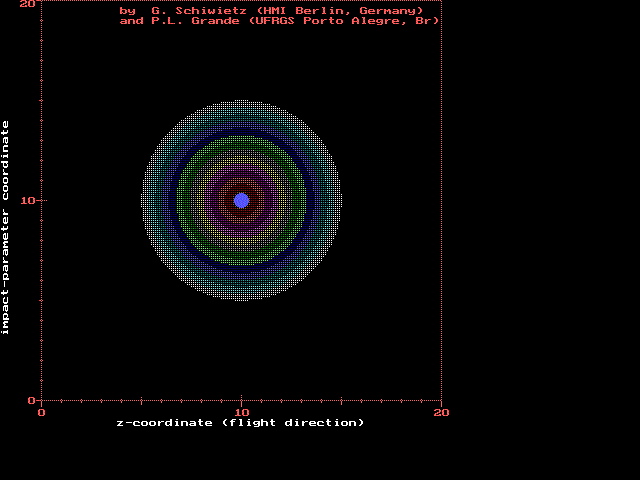Gregor Schiwietz
Select electron-capture scenario
Technical:
A contour plot of the time-dependent electron density for a hydrogen atom (the target nucleus is shown as a blue solid circle) disturbed by a charged particle (red solid circle with arrow) is displayed. The different colors correspond to an exponential density scale for a density cut in the collision plane (the plane spanned by the impact-parameter and the projectile-velocity vector). The first frame of the animation shows the initial hydrogen-1s electron cloud, a spherically symmetric exponential density distribution.
The density was calculated with our quantum mechanical atomic-orbital (AO) coupled-channel code by solving 172 coupled differential equations for the time-dependent amplitudes. These equations are directly related to the time-dependent Schrödinger equation and each amplitude contains the information on the population as well as the coherence properties for a certain basis state. For this example we have used only single-centered basis states that are (linear combinations of) eigenstates of the unperturbed target Hamiltonian. The coherent superposition of all basis states yields the time-dependent density shown below.
For z coordinates exceeding 5 to 10 a.u. a breakdown for the description of electron capture will appear, since projectile-centered states are NOT included in the basis chosen for this animation. Positively charged projectiles involve traveling bound states and thus, high-angular momentum states of the target continuum as well as target bound states are required for the simulation of electron capture with a single-centered basis. Therefore, we usually perform two-centre calculations, if the electron-capture channel turns out to be very important.
10 keV PROTON + HYDROGEN collision at an impact parameter of b = 1 a.u.
One may notice three effects during the course of the collision:
- The (positively charged) proton attracts the (negatively charged) electron on the incoming path (z coordinate < 0); the so-called polarization process. One may see that the electron density moves towards the projectile
- The proton enables electron-capture in the outgoing path of the collision and a large fraction of the electron density is finally bound to and moving with the projectile.
- The remaining target-centered electron density includes also highly excited states and correspondingly, the final density distribution is oscillating.
If you can stop the animation (use the < ESC > key in Netscape Navigator 3.0), you may stop it exactly at the distance of closest approach (z=0): The maximum of the electron-density points to the backward direction (at an angle of about 130 degrees with respect to beam axis). It is clearly visible that the electron density lies behind the projectile in this case, although the proton is attracting the electron. The reason for this behavior is a delayed response of the electron cloud (the inertia due to the electron mass).
Selected references on quantum treatments of light-ion / atom interactions:
- "Coupled-Channel Calculation of Stopping Powers for Intermediate-Energy Light Ions Penetrating Atomic H and He Targets" G.Schiwietz, Phys.Rev.A42, 296-306 (1990)
- "Electronic Stopping of Protons at Intermediate Velocities" G. Schiwietz and P.L. Grande, Nucl.Instr. and Meth. B69, 10-17 (1992)
- "Non-Perturbative Stopping Power Calculation for Bare and Neutral Hydrogen Incident on He" P.L. Grande and G.Schiwietz, Phys.Rev. A47, 1119-22 (1993)
- "Angular Dependence of Energy Loss in Proton-Helium Collisions" G. Schiwietz, P.L. Grande, C. Auth, H. Winter, and A. Salin, Phys.Rev.Lett. 72, 2159-62 (1994)
- "Non-perturbative treatment of the screened-Coulomb contribution of projectile-electron loss", P.L.Grande, G.Schiwietz, G.M. Sigaud, and E.C.Montenegro, Phys. Rev. A54, 2983-2990 (1996)

